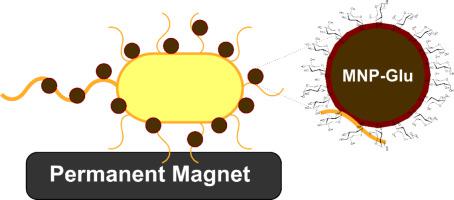Biomaterials Advances ( IF 5.5 ) Pub Date : 2020-07-06 , DOI: 10.1016/j.msec.2020.111267 Lucio Assis Araujo Neto 1 , Tatiane Melo Pereira 2 , Luciano Paulino Silva 3

|
Magnetic nanoparticles (MNPs) are a specific type of nanomaterial whose applications are widespread into several fields including biomedicine as a smart drug targeter and environmental engineering due to their interactions with contaminants. Lately, the use of MNPs has also been demonstrated in structuring three-dimensional (3D) cultures of mammalian cells. However, MNPs application to other cell types is still limited. In this sense, some planktonic microorganisms when adhered to surfaces perform the swarming phenomenon to guarantee the expansion of the colony and to guarantee more niches. Therefore, the aim of this study was to produce MNPs coated with four carbohydrates (galactose — gal, glucose — glu, sucrose — suc, and maltose — mal) aiming microorganism culture applications and also for possible 3D arrays. The results showed that carbohydrate-coated MNPs showed hydrodynamic diameters ranging from 100 to 200 nm and that their coatings influenced the chemical behavior in different ways. Indeed, when subjected to biological tests to determine their potential level of cytotoxicity, it was found that in concentrations of 1 mM, 800, 600, and 400 μM (iron equivalent), there was not any alteration on growth of model microorganisms when visually evaluated. Besides, magnetization of bacteria was promoted in different ways as well as the modulation of swarming formation in Escherichia coli when exposed to MNP-Glu. In sum, MNPs coated with carbohydrates and even uncoated were atoxic to bacteria and one of them was able to modulate E. coli swarming formation showing the potential for applications in 3D cultures of bacteria.
中文翻译:

涂有碳水化合物的磁性纳米颗粒用于细菌的3D培养。
磁性纳米颗粒(MNP)是一种特殊类型的纳米材料,由于其与污染物的相互作用,其应用已广泛应用于多个领域,包括作为智能药物靶向物的生物医学和环境工程。最近,在构造哺乳动物细胞的三维(3D)培养物中也证明了MNP的使用。但是,将MNP应用于其他细胞类型仍然受到限制。从这个意义上讲,某些浮游微生物附着在表面时会发生群聚现象,以确保菌落的扩展并确保更多的生态位。因此,这项研究的目的是生产覆盖了四种碳水化合物(半乳糖-gal,葡萄糖-谷氨酸,蔗糖-蔗糖和麦芽糖-mal)的MNP,旨在用于微生物培养应用以及可能的3D阵列。结果表明,碳水化合物包覆的MNPs的流体力学直径范围为100至200 nm,并且它们的包覆层以不同方式影响化学行为。实际上,当进行生物学测试以确定其潜在的细胞毒性水平时,发现在浓度为1 mM,800、600和400μM(铁当量)时,通过目测评估模型微生物的生长没有任何变化。 。此外,细菌的磁化促进了不同的方式,并且调节了蜂群的形成。在600和400μM(铁当量)下,通过目测评估模型微生物的生长没有任何变化。此外,细菌的磁化促进了不同的方式,并调节了蜂群的形成。在600和400μM(铁当量)下,通过目测评估模型微生物的生长没有任何变化。此外,细菌的磁化促进了不同的方式,并调节了蜂群的形成。暴露于MNP-Glu时的大肠杆菌。总而言之,涂有碳水化合物的MNPs甚至未涂覆的MNPs对细菌都是无毒的,其中之一能够调节大肠杆菌群的形成,显示出在3D细菌培养中的应用潜力。











































 京公网安备 11010802027423号
京公网安备 11010802027423号